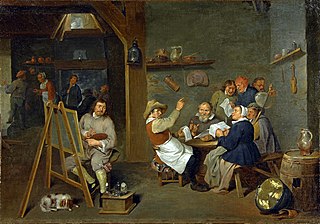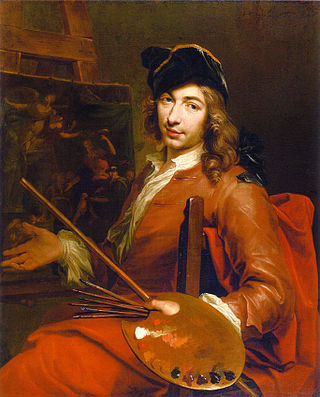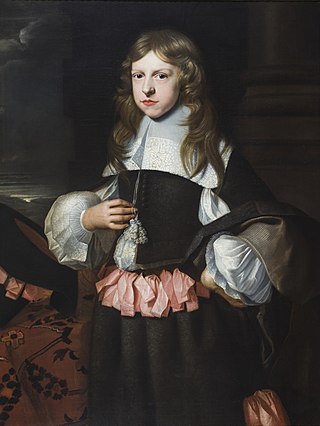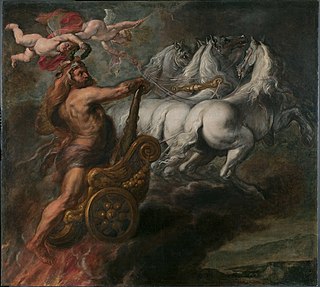
The Oude Voetboog Guild in the Grote Markt is a 1643 oil on canvas painting by David Teniers the Younger, in the collection of the Hermitage Museum, in Saint Petersburg. [1] It is signed and dated bottom left "DAVID. TENIERS. FEC. A 1643".

The Oude Voetboog Guild in the Grote Markt is a 1643 oil on canvas painting by David Teniers the Younger, in the collection of the Hermitage Museum, in Saint Petersburg. [1] It is signed and dated bottom left "DAVID. TENIERS. FEC. A 1643".
It was painted for the guild house's main hall. Teniers himself was a member of the guild and Klinge suggests that he painted it as a gift for the guild in return for exemption from guard duty, which was otherwise mandatory for all guild members. [2] The painting was owned by the guild until 1649, when it hit financial difficulties and had to sell both this work and Rubens's The Crowning of the Virtuous Hero to the painter Gerard Hoet.
Both works later became part of the Landgrave of Hesse-Kassel's collection, from which they were both looted by Napoleon's troops - Crowning is now back in Kassel's Gemäldegalerie Alte Meister. Guild was taken in 1806 and assigned to Napoleon's wife Josephine Beauharnais, who kept it at her Château de Malmaison until 1814, when she sold it with 37 other works to Alexander I of Russia. [3] [4] It has been in the Hermitage ever since. [5]
The background is Antwerp's Grote Markt, with the 1560s city hall on the left and Zilversmidstraat and the guild's base in the Huys van Spanien to the right. With over fifty people in the first and second rows, it is a guild group portrait, a popular genre in Flanders and the Dutch Republic between 1625 and 1650, the most famous of which is Rembrandt's The Night Watch , painted the previous year. Teniers himself had also approached the theme in a less static and ceremonial vein in The Guard Room .
Guild members are depicted in black dress with white collars and red cummerbunds. Three men also have red scarves over their shoulders - these are probably the leaders of the guild. To the left are a drummer and two men in yellow dress holding their muskets, whilst to the right is another man in yellow dress holds a standard at right and a priest in red, perhaps a cardinal, leans on a crossbow.
As early as the mid 18th century Jean-Baptiste Descamps suggested that the work showed a parade by various artisan guilds. [6] By contrast, Alfred Michiels considered that it showed an oath by the crossbowman guild, [7] whereas Frans Jozef Peter van den Branden argued that it showed a parade for the anniversary of the Dean of the Gudeward Sneijders Guild. [8] Margret Klinge considered that Van der Branden's theory is unlikely due to a lack of documentary evidence, but agreed that the picture depicts an unknown parade, as well as adding the detail that the guild's dean was then also mayor of Antwerp. [2]

David Teniers the Younger or David Teniers II was a Flemish Baroque painter, printmaker, draughtsman, miniaturist painter, staffage painter, copyist and art curator. He was an extremely versatile artist known for his prolific output. He was an innovator in a wide range of genres such as history painting, genre painting, landscape painting, portrait and still life. He is now best remembered as the leading Flemish genre painter of his day. Teniers is particularly known for developing the peasant genre, the tavern scene, pictures of collections and scenes with alchemists and physicians.

Nicolaes van Verendael or Nicolaes van Veerendael was a Flemish painter active in Antwerp who is mainly known for his flower paintings and vanitas still lifes. He was a frequent collaborator of other Antwerp artists to whose compositions he added the still life elements. He also painted a number of singeries, i.e, scenes with monkeys dressed and acting as humans.

David Ryckaert III, David Rijckaert III or David Rijckaert the Younger was a Flemish painter known for his contribution to genre painting, in particular through his scenes of merry companies and peasants. He also painted hell scenes and images of alchemists. He enjoyed the patronage of prominent patrons and was a painter to the court of the governor of the Southern Netherlands.

Artus Wolffort, Artus Wolffaert or Artus Wolffaerts (1581–1641) was a Flemish painter known mainly for his history paintings depicting religious and mythological scenes.

Lucas van Uden was a leading Flemish landscape painter, draughtsman and engraver, who lived and worked in Antwerp. He was a leading landscape painter who collaborated with various local figure painters. His most original works are his drawings.

Ambrosius Brueghel was a Flemish painter from the famous Brueghel family of artists. Less prolific and less well-known than a number of his family members, his oeuvre is not very well understood and is believed to comprise Baroque still lifes, garland paintings as well as landscapes.

Ferdinand van Apshoven the Younger or Ferdinand van Apshoven II was a Flemish painter and art dealer. He painted mainly genre scenes of peasants and taverns in the style of David Teniers the Younger. He was the brother of the better known painter Thomas van Apshoven who was also a follower of David Teniers.

Alexander van Bredael was a Flemish painter known for Italianate landscapes and genre scenes of fairs, cattle markets and villages. He was a prominent member of the Antwerp artistic family van Bredael.

Jacques Ignatius de Roore or Jacobus Ignatius de Roore was a Flemish painter, copyist, art dealer and art collector who worked in the Southern Netherlands and the Dutch Republic.
Juliaen Teniers or Juliaan Teniers was a Flemish painter of figures and flower pieces. He was a member of the extended Teniers family of painters.

Nicolaas van Eyck or Nicolaes van Eyck (1617–1679) was a Flemish painter active in Antwerp in the middle of the 17th century. He is known for his equestrian and battle scenes, landscapes and portraits. He also painted a few civil processions, including parades of the Antwerp civil militia.

Pieter Meulener or Peter Meulenaer, Antwerp), was one of the leading Flemish painters of battle scenes in the mid-17th century. He also painted landscapes with genre scenes.

Mattheus van Helmont was a Flemish painter specialized in genre scenes of interiors and village scenes. His style and subject matter were influenced by the work of David Teniers the Younger and Adriaen Brouwer. His preferred subjects were peasant feasts, wedding celebrations, drinkers and alchemists. He developed his own personal style towards the final phase of his career. He spent most of his active life in Antwerp but moved to Brussels later.

Zeger Jacob van Helmont, was a Flemish painter and tapestry designer who specialized in portraits and history paintings. He trained with his father in Antwerp but spent his active career in Brussels where he worked for the local churches and tapestry works.

Jacob van Reesbroeck or Jacob van Rysbroeck was a Flemish portrait painter and engraver from Antwerp whose patrons included prominent local families as well as foreign aristocrats and monarchs.

Jan van Helmont was a Flemish painter of history subjects, genre scenes and portraits.

Jan Baptist Boel or Jan Baptist Boel the Younger was a Flemish painter who specialised in still lifes and animal paintings. He collaborated with other painters in Antwerp for whom he added the still life elements or animals to their compositions.

Jan Baptist Borrekens or Jan Baptist Borkens was a Flemish painter and art dealer. He was a history painter and is known to have collaborated with Peter Paul Rubens.

Jan Thomas van Kessel was a Flemish painter and draughtsman. He was principally a genre painter who created scenes of peasants, wedding festivals and interiors of inns. He also painted some portraits and possibly also religious scenes. He was a member of the important van Kessel family of artists, which was related by marriage to the Brueghel family of artists.

The Guard Room is a 1642 oil on panel painting by David Teniers the Younger, now in the Hermitage Museum in St Petersburg. It is signed and dated "David Teniers F. 1642" at the bottom left. Several unsigned but probably autograph variants also survive, such as at the Catherine Palace near St Petersburg and the Walters Art Museum in Baltimore, USA. An early copy by an unknown artist after the Hermitage work is now in the National Museum of Sweden.